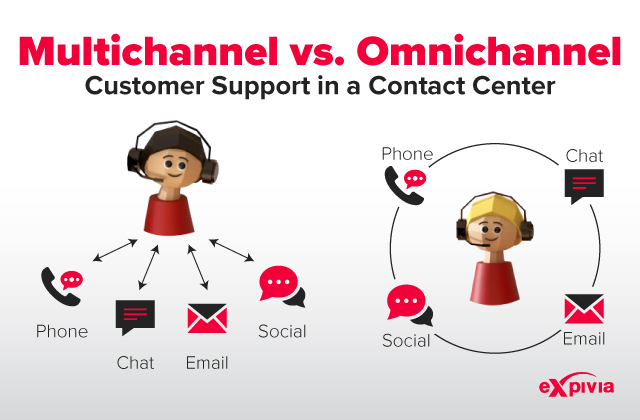What Is an Omnichannel Contact Center?

Great interactions define the success of your customer engagement center. And one of the best technical ways to ensure that is to become an omnichannel contact center.
If you’re not using this technology yet, find out why you should. And if you are, but you’re not getting the results you want, learn how to optimize your omnichannel contact center to reap all its benefits.
What Is an Omnichannel Contact Center?
Customers have multiple choices when it comes to contacting a business. Calling on the phone, writing an email, or sending a direct message on webchat are some of the most common ways your customers can get in touch with you.
Usually, customers don’t just use one of the above-mentioned methods. Instead, they use multiple channels based on their situation and what interaction is easiest for them.
An omnichannel contact center can handle conversations through phone, email, webchat, social media, apps, and chatbots all at the same time.
Why does that matter?
Well-integrated and connected communication channels ensure seamless conversations, quick conflict resolution, and a great customer service experience. Everything you need to keep your customers happy and ensure they work with you for the long term.
What’s the Difference Between a Multichannel and an Omnichannel Contact Center?
Years ago, there was a big push for call centers to become multichannel contact centers. Utilizing more than one form of contact with customers makes a lot of sense. After all, assigning one agent to the phone while another monitors email makes workforce management easy.
But, what if one agent could communicate with a customer through all channels, during the same interaction?
That is an omnichannel contact center.
In an omnichannel contact center, agents can talk to and service their customers through phone, email, webchat, apps, and social media all at the same time.
With well-connected and synced communication channels, omnichannel contact centers have the potential to reach more customers, increase first-call resolutions, and provide a seamless customer experience.

An Example of an Omnichannel Interaction
Let’s pretend a customer utilizes the chat widget on your website. Your agent starts a session with them.
Everything’s great until the customer needs to show a picture to the agent, but they can’t send it through chat.
In an omnichannel contact center, the agent could launch an outbound call to the customer, and explain on the phone how the customer can email the picture. While they’re on the phone, the agent can see the email and it can populate directly into the CRM.
Once the phone call ends the customer can continue with the chat session they started earlier.
These interactions aren’t separate. They’re all viewed as one. The call, the email, and the chat conversation get recorded as one interaction, not three separate ones. And the CRM memos reflect that too.
In a multichannel contact center, you would have had to end the chat session, make the call to the customer, hang up the phone, check the email, then call the customer back once you have the picture from the email.
While your agent goes through these steps the customer gets frustrated. Once they grow tired of waiting, they may even start up another chat session with a different associate. And this only confuses the situation.
Omnichannel session handling gives you the best chance of first call resolution (FCR) and helps you avoid customer frustration.
It’s an instant customer satisfaction (CSAT) and net promoter score (NPS) boost.
Why Have an Omnichannel Contact Center?
Does your organization dictate how your customers should interact with your company?
That’s a backward approach.
A lot of organizations make customers go through long drawn-out IVRs. Some don’t even have a phone number on their websites.
Switching to omnichannel makes your customers’ lives easier and benefits your business directly:
- Increased customer satisfaction: The reputation of your company depends on the service you give.
- Higher customer retention: After a positive customer experience, 69% of Americans would recommend that company to others. On the other hand, following a negative customer experience, 58% of Americans would never use that company again. With omnichannel customer service, you can keep more satisfied customers.
- Better sales: Lower customer churn and higher satisfaction rates result in more sales.
- Lower costs: While Omnichannel Platforms and call monitoring costs money, the overall cost-to-output ratio is better with omnichannel contact centers.
What Makes a Good Omnichannel Contact Center
Omnichannel customer service needs to be a seamless experience. To make sure your customers receive effective and efficient problem resolution, follows the four pillars of omnichannel support:
1. Seamless Connection Between Channels
No matter how the customer decides to contact you, the agent must easily see the customer’s journey. That’s how your agents can offer the fastest and most accurate service possible.
2. Secure and Intelligent Data Routing
One of the perks of omnichannel contact centers is connecting the customer’s data and personal information to their requests. You can use this data to intelligently route the customer’s case to the appropriate agent or department.
3. Integrated Applications
Every communication channel needs to be integrated. And adding a new channel needs to be an instant and easy process.
Most omnichannel contact center platforms have integration capabilities (either with built-in processes or APIs).
4. Monitoring the Right KPIs
Leading a good omnichannel contact center needs to include constant monitoring and adjustments.
The call center KPIs you choose to monitor matter. For omnichannel contact centers, customer satisfaction scores should matter more than the volume of calls.
7 Omnichannel Contact Center Best Practices
Setting up an omnichannel contact center is the best way to ensure that you’re providing world-class customer service.
Follow these 7 steps and best practices to truly make omnichannel support successful at your contact center.
1. Use a Cloud Contact Center Solution
When you’re switching to an omnichannel customer center from a multichannel one, you don’t need to start from scratch.
Moving your contact center to the cloud can make integration and data connection an easier process.
2. Integrate Other Tools as Well
Integrating your communication channels is crucial to building an omnichannel contact center. But, you can also integrate other useful tools to make the customer experience streamlined beyond your contact center.
Mobile applications, reservation tools, or a webshop can all be integrated into one system. Make sure you keep the customer’s comfort in mind when you integrate your business.

3. Map Out Your Customer’s Journey
Every omnichannel contact center should be seamless, simple, and efficient. Anything process that interferes with those goals damages the customer’s experience.
To ensure this happens, map out your customer’s journey to avoid useless IVR routing, data repetition, and drawn-out problem resolution.
4. Include AI
AI (artificial intelligence) is a great tool to have in a contact center. It can make analytics easier for agents and managers alike. Plus, it can also contribute positively to the omnichannel experience.
Self-service platforms can intelligently guide the customer to the most appropriate agent or department And voice recognition can help with security, data management, and customer satisfaction analytics.
5. Don’t Forget Social Media
A lot of contact centers focus on phone and email only. Some even include texts and web chat options. But, a lot of people forget about social media channels.
Failure to respond via social channels can lead to a 15% increase in the churn rate.
Customer interactions on social media can be very different, but an increasing number of people reach out to businesses over Facebook and Twitter.
Quick responses, regular monitoring, and effective problem resolution can make social media channels a very effective channel to engage and retain customers.
6. Maintain Service Level Consistency
The point of omnichannel customer service is to be there for the customer, no matter how they wish to contact you. More so, you need to provide the same level of service on all channels.
However, it’s not easy to maintain the same service levels. In fact, it’s sometimes impossible.
Still, managing customer expectations and defining user standards can make the difference between various channels less striking.
7. Track, Evaluate, and Adjust
Omnichannel customer support is constantly changing. You need to pay attention to what the customers want. Track their preferred methods of communication.
Afterward, adjust your scope and your focus to fit their needs. That’s how you become a reliable and trustworthy contact center in the customer’s eyes.
Omnichannel Is the Future of Contact Centers
Omnichannel contact centers make sense. It’s a great way to increase customer satisfaction and keep connected.
Yet, not many call centers realize these possibilities.
At Expivia, we know that omnichannel is the future. We leverage our platform and follow industry-wide best practices to deliver the most seamless and efficient customer service experience for our clients.
Are you interested in moving your contact center to omnichannel support? Reach out to us to learn more about the work we do, and how we can help you today!




